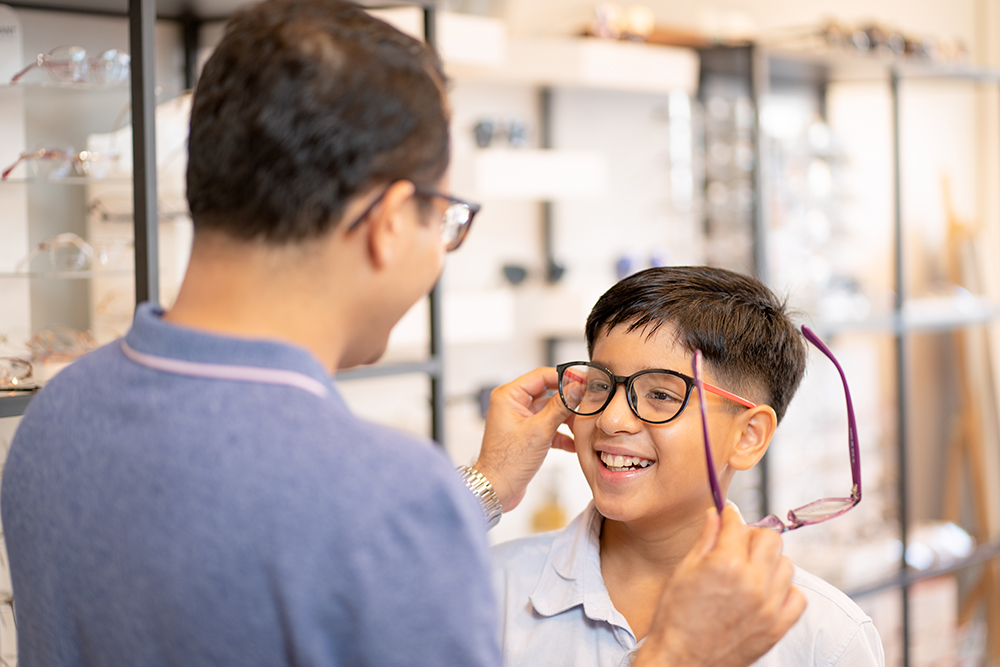How Healthy Are Your Child’s Eyes?

by Cheryl Maguire
“You need glasses,” the ophthalmologist said to me. I was twelve years old. My mom was shocked since I never complained of unclear vision and no one else in our family had poor eyesight. The reason I went to the doctor is that I failed the school eye screening exam. My vision became gradually worse so I didn’t realize it wasn’t normal.
I remember when I first wore glasses thinking to myself, “Everything seems so clear and crisp. I can see the tips of leaves on a tree and easily read street signs.” I thought it was normal to see the world a little bit blurry.
August is Children’s Eye Health and Safety Month. According to LetsGoSee.net, one in four children has a vision problem. The CDC reports that amblyopia, or lazy eye, is the most common cause of vision loss in children. It can be treated if caught early between the ages of 3 to 5 years old. Preventblindness.org reports that the most common vision disorders in children are myopia (nearsightedness, or trouble seeing far away), hyperopia (farsightedness, or trouble seeing close up), and astigmatism (blurry vision at all distances).
According to the Urban Child Institute, correcting poor vision can foster a child’s cognitive and social development. The American Optometric Association estimates 80% of a child’s learning happens through observation. In the classroom, most of the teaching is done by displaying the information. Children learn social skills from seeing facial expressions and body language.
Similar to my experience, children may be unaware of the fact their vision is not normal. This may lead to feeling frustrated about being unable to see the words in a book or on the board in the classroom causing a child to act out. The American Optometric Association reported that some children with learning difficulties exhibit specific behaviors of hyperactivity and distractibility.
“These children are often labeled as having Attention Deficit Hyperactivity Disorder (ADHD),” they wrote. “However, undetected and untreated vision problems can elicit some of the very same signs and symptoms commonly attributed to ADHD. Due to these similarities, some children may be mislabeled as having ADHD when, in fact, they have an undetected vision problem.”
Any of these signs may indicate that your child has a vision problem and needs to see an eye care professional.
Head Tilt. If your child has a problem with their ocular muscles or nerves they will attempt to compensate by til ting their head.
Sitting Too Close To The T.V. If your child is nearsighted, they will attempt to compensate for this by moving closer to the TV or reading materials.
Avoidance of Reading. If your child has poor visual skills and eye teaming skills they will compensate for this by avoiding reading. Reading uses many complex eye movements, and poor visual skills may cause your child to become frustrated easily.
Frequent Headaches. Your child may have headaches because he/she is overstrained using all of their energy to align, focus and use their eyes.
Laterality Problem. If your child has poor directional skills and often confuses left and right it could be due to poor vision. Proper oculocentric location is dependent on vision andlaterality depends, in part, upon oculocentric location.
Finger Pointing. If your child has poor vision tracking skills they may use their finger to compensate for their poor tracking ability.
Can’t Copy From The Board. Your child may have difficulty with accommodation, the ability to change focus between far and near. This is essential for success in school.
Squinting. Your child may squint because this narrows a bundle of light entering the eye which allows for sharper vision. Your child may be squinting because this act compensates for blurry vision.
Poor Hand/Eye Coordination. This skill is required for everything from writing notes in class to playing ball with friends. Clear vision and adequate visual skills are required to create an accurate link between vision and other body movements.
Eye Rubbing / Squinting. Rubbing: This is a basic response to ocular discomfort. It typically occurs when one’s eyes are strained or have been working too hard to complete a task. Squinting is used to narrow a bundle of light entering the eye which allows for sharper vision. Your child may be squinting because this act compensates for blurry vision.
About the Author: Cheryl Maguire holds a Master of Counseling Psychology degree. She is married and is the mother of twins and a daughter. Her writing has been published in The New York Times, Parents Magazine, AARP, Healthline, Your Teen Magazine, and many other publications. You can find her on Twitter @CherylMaguire05.









